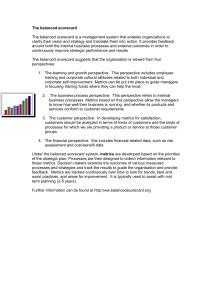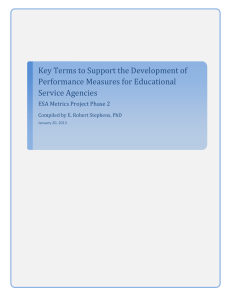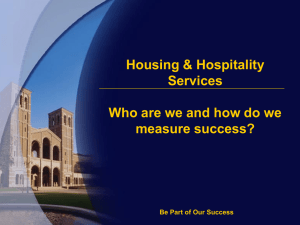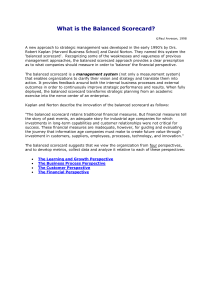Using HR Metrics to Support Strategic Planning and Employee
advertisement
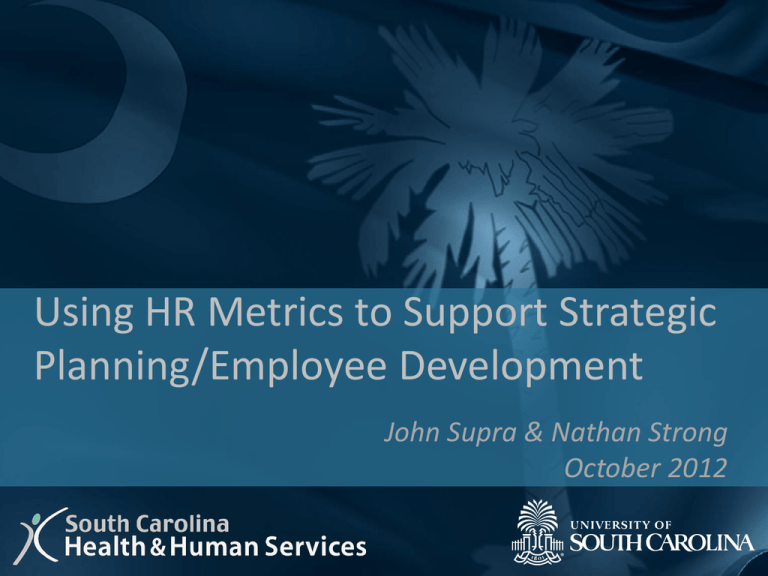
Using HR Metrics to Support Strategic Planning/Employee Development John Supra & Nathan Strong October 2012 A Strategic Asset for Transformation Beyond Transactions • Connection of Strategy with Talent • Source for Recruitment • Home for Workforce Investment – Training programs – Retention and reward programs • Leads Organizational Structure • Supports the Culture Organizational Structure • Alignment with Strategy • Away from Hierarchy Driven – Projects and teams • Valuing Management AND Expertise • Responsibility beyond Number of Reports • Public Sector Challenges Balancing How We Value People Knowledge Expertise Assets Projects Individual Leader Growth Finance Program Areas (Business/Ops) Technology 6 SC DHHS Workforce Number of Employees vs. Years of Service (Avg 8.1 years) 180 160 140 120 100 80 60 40 20 0 0 1 2 3 4 5 6 7 8 9 10 11 12 13 14 15 16 17 18 19 20 21 22 23 24 25 26 27 28 29 30 33 Number at 10 years of service is related to agency transfer. Balanced Scorecard Adapted from Kaplan & Norton, “Using the Balanced Scorecard as a Strategic Management System,” HBR (Jan-Feb 1996). Connecting to Business Goals • Balanced Scorecard in Public Sector • Tying Performance to Balanced Scorecard – Key initiatives in each area – Developing strategy and planning that connects with Balanced Scorecard – Connecting each employee’s metrics with the Balanced Scorecard SC DHHS Initiatives • • • • • • • Performance & Accountability Driven Reduce Silos – Management Levels Align with Goals not Funding Workforce Skills & Expertise Elevation Lean Six Sigma – Process Improvements Bonus Incentive Linked to Performance Flexibility in Compensation Structure Metric Driven Planning & Performance Management SC DHHS Draft Metrics Attract, Train, and Retain High Performers • Strengthen Recruitment & Hiring • Average length of service • Voluntary separation rate • Turnover by area/class • Performance Ratings (# high vs. average) • Average Training Investment per Employee • Average Training Investment per Supervisor • New Employee Training (# and investment) • Percent of Staff Training (CPM, Six Sigma, etc…) Provide Consulting Services for Risk Avoidance Improve Employee Accountability and Engagement and Ensure Appropriate Rewards • 100% Meaningful Performance Reviews • Balanced Bonus Program (performance/project) • # and Investment of Bonus Awards • Investment in Employee Events • Wellness Events Enhance Human Resources Operations • Number of Complaints Addressed • Customer Service – Manager Surveys • Number of Grievances/Settlements/EEOC • Index of Worker’s Compensation Costs • Number of Disciplinary Actions • EAP Utilization • Process Efficiency and Effectiveness – Transaction Cycle Times • Maintain Appropriate Level of Labor Costs • HR Help Desk Turn-Around Times • Benefits Services (# and timeliness) USC Strategic Plan Focus Carolina is the University of South Carolina’s Strategic Plan guides us in our decision making for USC’s future. We commit to seven focus areas: • • • • • • • Educational Quality Leadership Innovation Diversity Access Global Competitiveness Community Engagement Academic Dashboard Unveiled in January 2012 Selection of metrics – Relatively small number – Broad impact – Students and faculty Selection of comparison groups – Peer and peer‐aspirant – Similar mission and size – Competitors USC’s Success Critical Areas • • • • Cost Effectiveness of Business Practices Sustainable and Productive Workforce Improving the Work Environment Enhancing Operational Effectiveness Cost Effectiveness Result Area Cost Effective Business Practices that Enhance Competitiveness in Higher Ed Marketplace Success Drivers Competitive Pay for Faculty and Staff Mitigation of Employment Related Risk and Exposure Maintain Appropriate Level of Labor Costs Competitiveness of faculty salaries vs. identified job markets Index of WC costs; settlement costs; employee claim costs; impact of EAP Avg. Comp. and Benefits per FTE; % of total budget devoted to employee comp and benefits Key Metrics Workforce Result Area Creating a Sustainable and Productive Workforce Success Drivers Successful Hiring Practices Investment in Employee Development % of new hires who become high performers in 2 yrs.; Total separations from USC w/in 1 yr./Total hires for same year % of staff participating in professional development; improvement in Needs Assessment results index Key Metrics Retention of Talent Work Environment Result Area Improving the Work Environment for USC Employees Success Drivers Employee Engagement Key Metrics Employee Engagement survey results by work unit Effective Supervision and Recognition of Employees Number of Employees receiving recognition/all employees % of supervisors trained in core programs HR Operational Effectiveness Result Area Enhancing the Operational Effectiveness of the HR Function Success Drivers Key Metrics Customer Service Process Efficiency and Effectiveness Customer Service survey results by program area Index of performance measures by Program Area Partner feedback on process changes # of processes reviewed and documented The Value of HR Metrics • Reveals progress toward critical organizational goals • Keeps HR focused on matters important to the University • Ensures that issues that affect the workforce are considered in planning efforts Questions & Discussion
